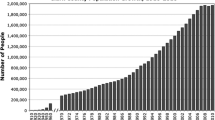Abstract
This paper analyzes how people define their relation to different forms of community. Interviews with 77 Californians revealed that respondents either chose a community identity as a city person, suburbanite, small-town person, or country person, or rejected such identification as meaningless, stigmatizing, constraining, or a source of identity conflict. Those who identify express a sense of belonging, based on ties of sentiment, interest, value, or knowledge. They also use community imagery to interpret self: Self-designated city people, for instance, characterize themselves as active, liberal, city-wise; small-town people, as friendly, family-oriented, less materialistic, unpermissive; country people, as easy-going, independent, practical, ordinary, outdoor folk; suburbanites, as people of the middle ground. This rich, complex pattern of community identification suggests the limited value of traditional sociological images of community decline and placelessness.
Similar content being viewed by others
References
Allen, Irving Lewis (ed.) 1977 New Towns and the Suburban Dream. Port Washington, NY: Kennikat Press.
Berger, Bennett 1960 Working-Class Suburb. Berkeley: University of California Press.
Berger, Peter and Thomas Luckmann 1967 The Social Construction of Reality. Garden City, NY: Doubleday.
Buttel, Frederick and William Flinn 1975 “Sources and consequences of agrarian values in American society.” Rural Sociology 40:134–151.
Cooper, Clare 1974 “The house as a symbol of self.” In Jon Lang et al. (eds.) Designing For Human Behavior. Stroudsburg, Pennsylvania: Dowden, Hutchinson, and Ross.
Csikzentmihalyi, Mihaly and Eugene Rochberg-Halton 1981 The Meaning of Things: Domestic Symbols and the Self. Cambridge: Cambridge University Press.
Dillman, Don A. 1979 “Residential preferences, quality of life, and the population turnaround.” American Journal of Agricultural Economics 61:960–966.
Dobriner, William 1963 Class in Suburbia. Englewood Cliffs, N.J.: Prentice Hall.
Donaldson, Scott 1969 The Suburban Myth. New York: Columbia University Press.
Duncan, James (ed.) 1982 Housing and Identity. New York: Holmes and Meier.
Fischer, Claude S. 1982 To Dwell Among Friends. Chicago: The University of Chicago Press.
Fischer, Claude S., et al. 1977 Networks and Places. New York: The Free Press.
Freese, Wolfgang and Frank M. Howell 1983 “Size of place, residential preferences and the life cycles: How people come to like where they live.” American Sociological Review 48:569–580.
Fugitt, Glen and James Zuiches 1975 “Residential Preferences and Population Distribution.” Demography 12:491–504
Glaser, Barney and Anslem Strauss 1967 Chicago: Aldine Publishing Company.
Goist, Park 1977 From Main Street to State Street. Port Washington: Kennikat Press.
Goldman, Robert and David Dickens 1983 “The selling of rural America.” Rural Sociology 48:585–606.
Hofstadter, Richard 1955 The Age of Reform. New York: Vintage Books.
Hummon, David 1980 “Popular images of the American Small Town.” Landscape 24:3–9.
Hunter, Albert 1974 Symbolic Communities. Chicago: University of Chicago Press.
Karp, David, Gregory Stone, and William Yoels 1977 Being Urban. Lexington, MA: D.C. Heath.
Kasarda, John and Morris Janowitz 1974 “Community attachment in mass society.” American Sociological Review 39:328–339.
Klapp, Orin 1969 Collective Search for Identity. New York: Holt.
Lingeman, Richard 1980 Small Town America: A Narrative History, 1620-present. Boston: Houghton Mifflin.
Lofland, Lyn 1973 A World of Strangers. New York: Basic Books.
Marx, Leo 1968 “Pastoral ideals and city troubles.” In The Fitness of Man's Environment. Smithsonian Annual II. Washington, DC: Smithsonian Institute Press.
Meinig, Donald W. 1979 “Symbolic landscapes: Some idealizations of American communities.” Pp. 135–145 in Donald W. Meinig (ed.), The Interpretation of Ordinary Landscapes: Geographical Essays. NY: McGraw-Hill.
Muller, Peter O. 1981 Contemporary Suburban America. Englewood Cliffs, NJ: Prentice-Hall.
Packard, Vance 1972 A Nation of Strangers. New York: McKay.
Perin, Constance 1977 Everything in Its Place. Princeton, NJ: Princeton University Press.
Peshkin, Alan 1978 Growing Up American. Chicago: University of Chicago Press.
Rapoport, Amos 1982 The Meaning of the Built Environment. Beverly Hills: Sage.
Reed, John Shelton 1983 Southerners: The Social Psychology of Sectionalism. Chapel Hill: The University of North Carolina Press.
Relph, Edward 1976 Place and Placelessness. London: Pion Limited.
Riulin, Leanne 1982 “Group membership and place meanings in an urban neighborhood.” Journal of Social Issues 38:75–93.
Rowles, G.D. 1983 “Place and personal identity in old age: Observations from Appalachia.” Journal of Environmental Psychology 3:299–313.
Schwartz, Barry 1976 “Images of suburbia: Some revisionist commentary and conclusions.” In Barry Schwartz (ed.), The Changing Face of the Suburbs. Chicago: University of Chicago Press.
Seamon, David 1979 A Geography of the Lifeworld. New York: St. Martin's Press.
Smith, Page 1966 As a City upon a Hill: The Town in American History. Cambridge: The MIT Press.
Stein, Benjamin 1976 “Whatever happened to small-town America?” The Public Interest 44:17–26.
Stein, Maurice 1960 The Eclipse of Community. Princeton, NJ: Princeton University Press.
Stoneall, Linda 1983 “Where are you from? A case of rural residential identification.” Qualitative Sociology 6:51–65.
Strauss, Anselm 1961 Images of the American city. New York: The Free Press.
Suttles, Gerald 1968 The Social Order of the Slum. Chicago: The University of Chicago Press.
Vidich, Arthur and Joseph Bensman 1960 Small Town in Mass Society. Garden City: Anchor Books.
Warner, Sam 1962 Street Car Suburbs. Cambridge: The MIT Press.
Webber, Mel 1970 “Order in diversity.” Pp. 792–811 in R. Gutman and D. Popenoe (eds.) Neigh-borhood, City and Metropolis. New York: Random House.
Wirt, Frederick 1974 Power in the City. Berkeley: University of California Press.
Wirth, Louis 1938 “Urbanism as a way of life.” American Journal of Sociology 44:1–24.
Zuiches, James J. 1981 “Residential preferences.” Pp. 247–255. In Don A. Dillman and Daryl J. Hobbs (eds.) Rural Society in the U.S.: Issues for the 1980s. Boulder, CO: Westview.
Author information
Authors and Affiliations
Additional information
The author would like to thank Claude Fischer and Lyn Lofland, for their continued support of this work, and Steven Ainley, Peter Conrad, and Royce Singleton, Jr., for their comments on earlier versions of this paper.
Rights and permissions
About this article
Cite this article
Hummon, D.M. City mouse, country mouse: The persistence of community identity. Qual Sociol 9, 3–25 (1986). https://doi.org/10.1007/BF00988246
Issue Date:
DOI: https://doi.org/10.1007/BF00988246




